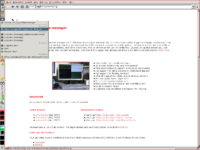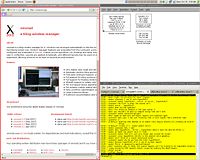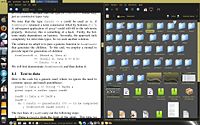Xmonad/Using xmonad in Gnome
Introduction
Xmonad makes an excellent drop-in replacement for Gnome's default window manager (metacity) giving you a slick tiling window manager. This guide will help you set up Gnome to use Xmonad 0.9.
This is an update to the previous page on Xmonad/Using xmonad in Gnome/0.6.
Setting up Gnome to use Xmonad
Overall most people on a variety of distros seem to get best results with telling gnome to use xmonad instead of metacity with
# gconftool-2 -s /desktop/gnome/session/required_components/windowmanager xmonad --type string
You also need two xmonad.desktop files on your system. If your distro doesn't provide them, create the following files:
$ cat /usr/share/applications/xmonad.desktop [Desktop Entry] Type=Application Encoding=UTF-8 Name=Xmonad Exec=xmonad NoDisplay=true X-GNOME-WMName=Xmonad X-GNOME-Autostart-Phase=WindowManager X-GNOME-Provides=windowmanager X-GNOME-Autostart-Notify=false $ cat /usr/share/xsessions/xmonad.desktop [Desktop Entry] Encoding=UTF-8 Name=XMonad Comment=Lightweight tiling window manager Exec=xmonad Icon=xmonad.png Type=XSession
simono says creating /usr/share/xsessions/xmonad.desktop and /usr/local/bin/xmonad.start files is the preferred method. See
arjuna's blog for more details. (The applications/xmonad.desktop file is still required.)
Ubuntu Karmic
One user says "apparently ubuntu removed .xsession support and the WINDOW_MANAGER env variable is now ignored. I tried a few things and eventually used gconf-editor to edit to set required_components windowmanager to xmonad.
# gconftool-2 -s /desktop/gnome/session/required_components/windowmanager xmonad --type string
Another user reports that WINDOW_MANAGER still works, but he had to delete ~/.gconf directory (as in Jaunty) before it was recognized - even after a clean install.
You can also do this from gnome menus by creating a new item in
System>Preferences>Startup Applications menu Programs tab to run xmonad as
window manager.
For example, for Name: you could use "Window Manager XMonad", then
for Program: use xmonad. Un-check the old "Window Manager"
one with Program gnome-wm (don't delete or over-write it
so you can switch back if you want) then click the checkbox to turn on the
new "Window Manager XMonad" entry instead, log out and log back in choosing
gnome-session.
(Not a great method for people who switch frequently between metacity, compiz, and xmonad.)
Ubuntu Jaunty
At least 3 XMonad users have found that the ~/.gnomerc will not work on Jaunty Ubuntu when one is upgrading from Intrepid; apparently the ~/.gconf/ directory is incompatible or something, so Gnome/Ubuntu will not read .gnomerc and any settings in it will be ignored.
The work-around is essentially to remove .gconf entirely. On the next login, a fresh default .gconf will be created and .gnomerc will be read. This of course implies that one's settings and preferences will also be removed, and one will have to redo them. (Copying over selected directories from the old .gconf to the new one may or may not work.)
Or alternatively, the following worked for me (without touching .gconf or .gnomerc or exports): Add an xmonad launcher in the gnome-session-properties and then execute:
$ gconftool -t string -s /desktop/gnome/applications/window_manager/current xmonad $ gconftool -t string -s /desktop/gnome/session/required_components/windowmanager xmonad $ killall metacity; xmonad &
Also make sure to add the /usr/share/applications/xmonad.desktop file shown above, if it's not already present. This lets gnome know that xmonad is a windowmanager and where to look for it.
Ubuntu Intrepid
This forum thread has instructions for making Gnome play nice with xmonad on intrepid.
Fedora 10 and further links
This mailing list thread contains fedora 10 specific setup instructions, but also a bunch of other gnome setup links if you are having trouble with the above methods.
None of this worked for me (Colin Adams). What did work was to start gconf-editor and change desktop/gnome/session/required_components/windowmanager from metacity to $HOME/bin/xmonad . I then have to type "xmonad" from a terminal.
Configure Xmonad to interoperate with Gnome
Using the Config.Gnome module
For xmonad-0.8 or greater, see Basic DE Integration for a simple three line xmonad.hs configuration that:
- integrates docks and gnome-panel using ewmh's
- allows gap-toggling
- binds the gnome run dialog to mod-p, and mod-shift-q to save your session and logout
- otherwise keeps xmonad defaults.
It is a good starting point. You can then come back and add some of the features below once everything's working.
Once the Config.Gnome module set up, you may want to customize these gnome settings.
Keys
Use EZConfig to add keybindings. Note that you must use gnomeConfig whereever defaultConfig is mentioned.
import XMonad
import XMonad.Util.EZConfig
main = xmonad $ gnomeConfig
{ terminal = "urxvt"
, modMask = mod4Mask -- set the mod key to the windows key
}
`additionalKeysP`
[ ("M-m", spawn "echo 'Hi, mom!' | dzen2 -p 4")
, ("M-<Backspace>", withFocused hide) -- N.B. this is an absurd thing to do
]
ManageHooks
Be sure to include the default gnome manageHook when overriding manageHooks so that xmonad can leave a gap for gnome-panel:
main = xmonad gnomeConfig
{
...
, manageHook = composeAll
[ manageHook gnomeConfig
, title =? "foo" --> doShift "2"
-- needs: import XMonad.Hooks.ManageHelpers (isFullscreen,doFullFloat)
, isFullscreen --> doFullFloat
]
...
}
Layouts
When overriding the default layouts, you must manually apply the desktopLayoutModifiers layout modifier.
import XMonad.Config.Desktop (desktopLayoutModifiers)
main = xmonad gnomeConfig
{
...
, layoutHook = desktopLayoutModifiers (Tall 1 0.03 0.5 ||| Full)
...
}
Tweak Gnome to work better with Xmonad
These are a few steps that greatly improves the experience of running Xmonad under Gnome. Note that on some systems the binary gconftool is called gconftool-2.
Disable the Nautilus desktop
This step is not required, but some users prefer to disable the desktop. From the command line execute:
gconftool --type boolean --set /apps/nautilus/preferences/show_desktop false
(Using recent gnome and xmonad I found that it was necessary.)
Changing desktop background
If you need to change the workspace background programmatically (i.e. from some extension setting in xmonad's configuration file), you can use the command:
gconftool --type string --set /desktop/gnome/background/picture_filename "/path/to/your/image.png"
Display XMonad logHook in gnome-panel
See xmonad log applet for a panel applet to display xmonad's logHook in gnome-panel via dbus
Key bindings for switching desktops
In 1 dimension: CycleWS
Gnome lays out the desktops in a row by default, and uses Ctrl+Alt+Left/Right for switching desktops left/right. To get similar behaviour in Xmonad, you need to add some keybindings. The contrib module XMonad.Actions.CycleWS has some useful actions for cycling workspaces:
main = xmonad gnomeConfig
{ modMask = mod4Mask }
`additionalKeysP`
[
...
-- moving workspaces
, ("M-<Left>", prevWS )
, ("M-<Right>", nextWS )
, ("M-S-<Left>", shiftToPrev )
, ("M-S-<Right>", shiftToNext )
]
In 2 dimensions: Plane
If Gnome is configured to lay out desktops in more than one line, it's possible to navigate with Ctrl+Alt+Up/Bottom also. The contrib module XMonad.Actions.Plane, available in the xmonad-0.8 or greater. The keybindings can be incorporated in with EZConfig as such:
import XMonad
import XMonad.Config.Gnome
import XMonad.Actions.Plane
import XMonad.Util.EZConfig
import qualified Data.Map as M
main = xmonad $ gnomeConfig
{ terminal = "urxvt"
, modMask = mod4Mask -- set the mod key to the windows key
}
`additionalKeysP`
[ ("M-m", spawn "echo 'Hi, mom!' | dzen2 -p 4")
, ("M-<Backspace>", withFocused hide) -- N.B. this is an absurd thing to do
]
`additionalKeys`
M.toList (planeKeys mod4Mask GConf Finite)
Actions.WorkspaceCursors can be used to navigate workspaces arranged in three or more dimensions.
Logging out of the Gnome session vs. quitting Xmonad
When running Xmonad as above, it is launched by gnome-session, the "Gnome session manager." Quitting Xmonad in this situation will not log you out. If you make no changes, using mod+shift+q will leave you with all your applications still running and no window manager to navigate them! There are several remedies for this.
* Run 'xmonad &' from a command line. * Quit X using Alt-Ctrl-Backspace. * Rebind mod+shift+q
Rebind mod+shift+q
To avoid exiting Xmonad and being stuck with no window manager, you might rebind mod+shift+q to execute the gnome-session "log out" functionality. This will of course prevent you from "quitting" Xmonad in the normal way, which may or may not be desirable. When the session logs out, the X11 server is terminated, which will in turn terminate all running X11 applications, including Xmonad.
(TODO: improve the description of changes that need to be made here.)
, ("M-S-q", spawn "gnome-session-save --gui --logout-dialog") )
Configure rudimentary power management
It might be useful to include bindings for hibernation, screen locking, and other assorted basic functions. While Gnome provides the capability to do so, it's functionality is limited (Mod4 cannot be used as a mask), and you may prefer to have Xmonad manage it. Fortunately, these things can be controlled from the command line, and the following bindings may help. (NB: These are for one handed use of Dvorak control; make sure to bind them to something more fitting. They also use mod1 not to clash with mod4 by accident.)
-- Lock Screen
, ("M-S-l", spawn "gnome-screensaver-command -l")
-- Logout
, ("M1-M-S-l", spawn "gnome-session-save --gui --kill")
-- Sleep
, ("M1-S-'", spawn "gnome-power-cmd.sh suspend")
-- Reboot
, ("M1-S-,", spawn "gnome-power-cmd.sh reboot")
-- Deep Sleep
, ("M1-S-.", spawn "gnome-power-cmd.sh hibernate")
-- Death
, ("M1-S-p", spawn "gnome-power-cmd.sh shutdown")
Configure the session manager to relaunch Xmonad
You can configure the Gnome Session Manager to restart Xmonad whenever it exits (i.e., if you haven't rebound mod-shift-q.) This is rarely a useful feature as xmonad has its builtin compile-and-restart (mod-q), but it will prevent you from accidentally ending up with no window manager and no way to launch one.
However, as of version 0.7, XMonad does not itself communicate with any session managers in they way they prefer, so setting things up takes some hackery:
(TBD: steps, see also Xmonad/Using_xmonad_in_Gnome/0.5#Preparing_your_GNOME_session)



